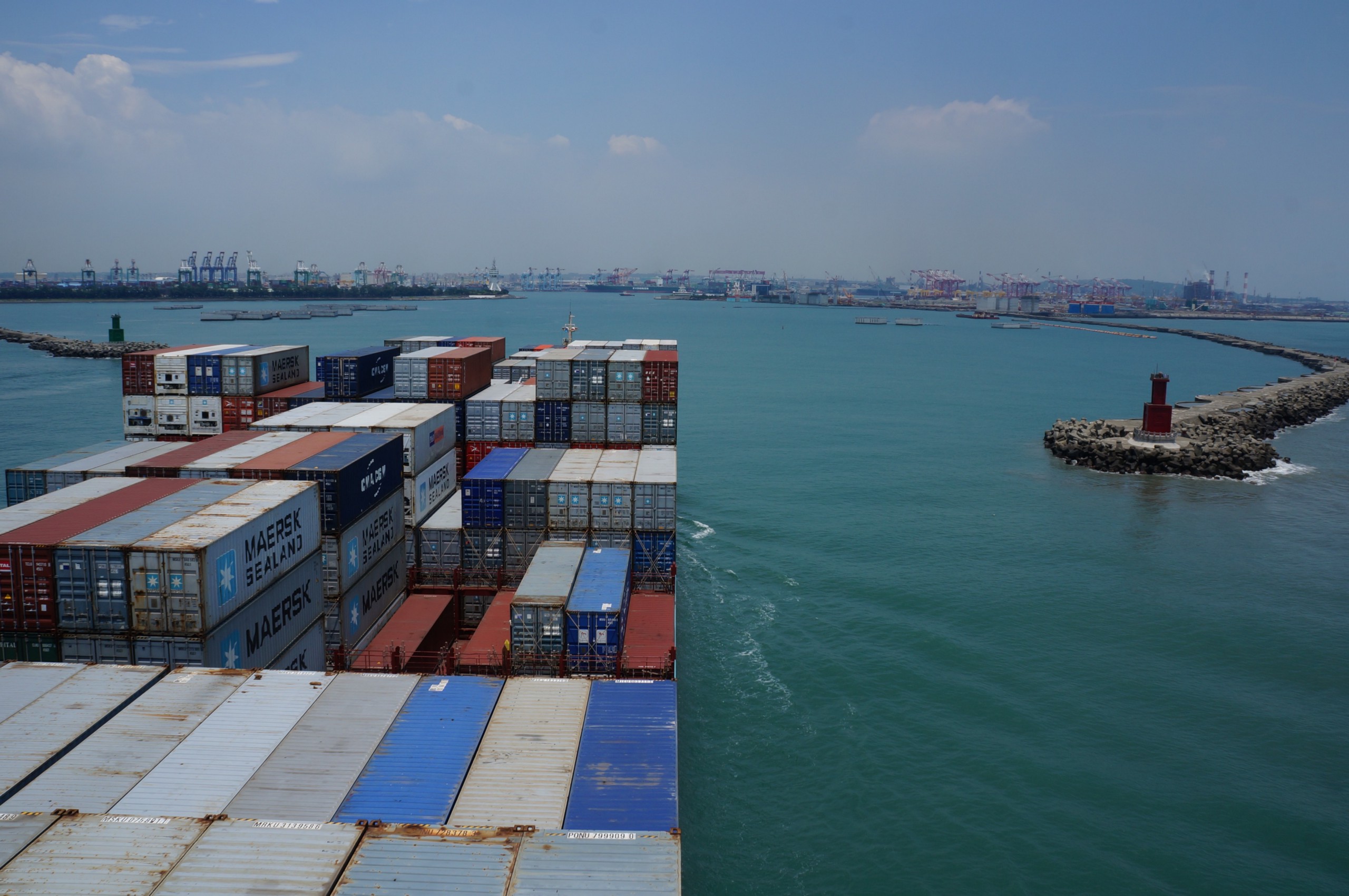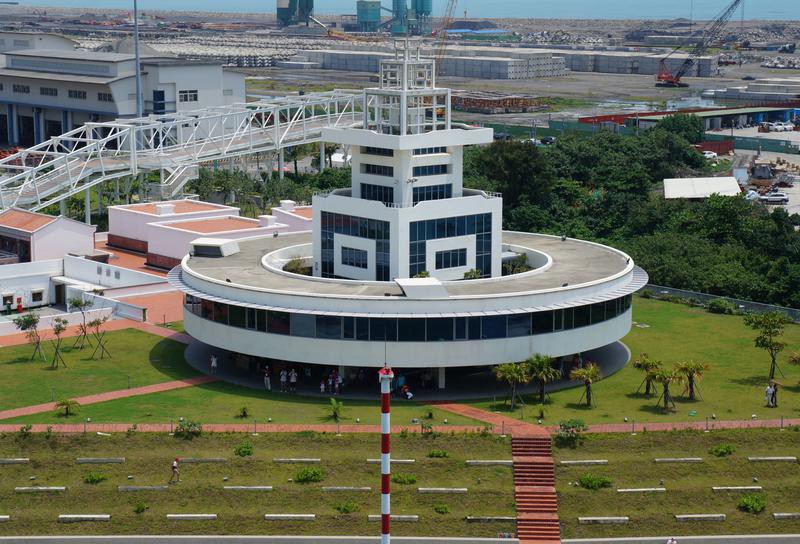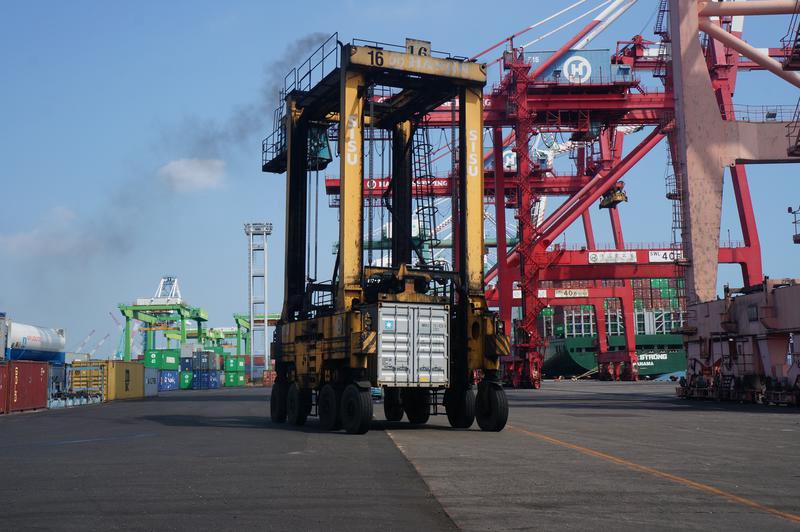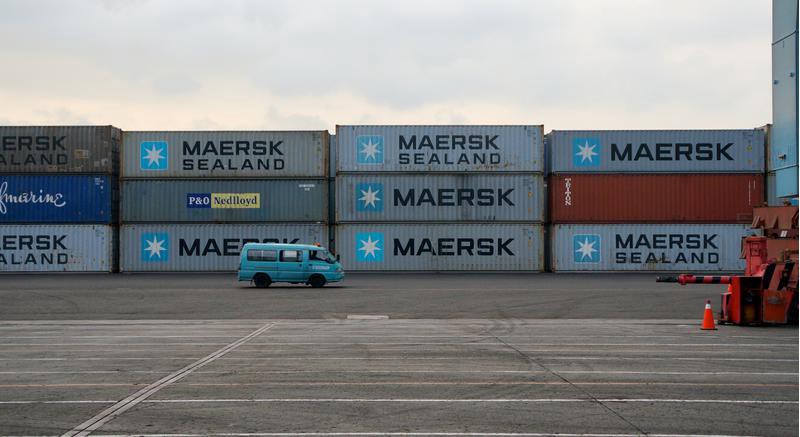

Read the next installment: “Our Friend, the Twistlock“
Read the previous installment: “From Whisky to Wifi“

Approaching the port of Kaohsiung, our pilot is having an intense, rapid exchange over the radio. As we close in on the narrow gap in the breakwater he turns to explain. He’s coordinating with all the other pilots about which ship is going where and in what order. Kaohsiung’s port is constrained, with ship movements carefully choreographed. Our 1,050-foot-long post-Panamax vessel is part of this ballet.
Entering the harbor I see something I haven’t encountered elsewhere on our journey. Families wave joyously to the ship from a revolving restaurant. The other ports we’ve visited have been in remote industrial areas, away from the general public. Workers who see ships day after day tend not to wave.
I enthusiastically wave back from the bridge, doing my best to impersonate an extra in the opening sequence of the movie Titanic.

The port is expanding, prompting the city’s relocation of the Hong Mao Gang Village. The waving families are visiting the Hongmaogang Cultural Park, which was built in 2007 when the village was moved, to preserve its history with exhibitions about the community and replicas of old village houses. Soon, even larger ships will be able to call at the Port of Kaohsiung’s Intercontinental Container Terminal, adding to the seemingly endless expanse of red and green Evergreen-branded containers stacked on the quays.
“Can we go visit that restaurant? Is it inside the port?” I ask the captain, who seems to know all the decent eateries overlooking any port. He’s not been to this one, but tells me to take shore leave and ask a taxi driver to take me there. I hadn’t realized that everyone on the ship has the option of shore leave at Kaohsiung, unless they are on duty.
We carefully cross the quay to the shuttle bus that will take us to the port entrance. The bus is tiny, smaller than the individual containers stacked around us. Straddle carriers weave by, strange truck/crane hybrids that wouldn’t look out of place in an episode of Thunderbirds.

At the port entrance I bump into four of the crew getting into a taxi. They’re trying to haggle down the U.S. $40-fare, but since there’s no other taxis around they don’t have much leverage. The city center’s too far away to walk and we don’t know the local public transport system. The only other option is to return to the ship. They finally relent and agree to the fare. It’s their first shore leave since departing Latin America weeks previously.
Another cab turns up for me and a few others. The driver, Mr. Winna, asks where we’d like to go and what we need. We’re not sure. He mimes possibilities at us. Some shampoo and soap? Some food? Some beer? The usual things a sailor wants on land. We opt for the normal shore-leave experience–and whatever that entails. For $10 each Mr. Winna will take us wherever we want for three hours and get us back to the ship before it leaves.
He knows everything a visiting sailor might need in a hurry. Heading into town he offers us currency exchange, converting U.S. money into New Taiwan dollars at a fair rate. Later he passes around a price list for a local massage parlor.

We arrive at a store that carries everything one might need after weeks at sea. It’s a Carrefour, a branch of the French hypermarket chain store. And it’s attached to an outlet mall featuring a Nike clearance store and a KFC. Next door there’s an Ikea. I’ve flown halfway around the world and spent a week traveling by sea only to find myself in a retail park much the same as the ones outside any European city.
Mr. Winna waits for us in the menswear shop his wife runs. If we need anything, though, we can go see him or give him a ring. We walk through the city instead. Down the road we find ourselves at Dream Mall, full of high-end fashion stores like Dior and Chanel. I wonder if stock for these shops is currently being unloaded from our ship.
Quickly our three hours are up and we’re back at the port, arriving at the shuttle bus at the same time as some of our crew. They’re bubbling with energy and joking around, showing us their purchased goods and sharing photos they’ve taken posing with mannequins in a lingerie store. They’re the happiest I’ve seen anyone. We all pile into the tiny bus, far more of us than there are seats. “It’s fine,” one of them jokes as we squeeze in, “we’ll travel Indian style!”

It’s surprising how uplifting just a few hours on land can be. Aboard the ship the topic of missing sturdy ground comes up. It’s trees and greenery that folks mention the most. The captain is looking forward to gardening in an allotment upon retiring. Another officer wants to quit and buy a farm instead. But for now we’re back at sea, departing the turquoise blue waters of Kaohsiung into the Taiwan Strait.

Read the next installment: “Our Friend, the Twistlock“
Read the previous installment: “From Whisky to Wifi“
Please note that this work is not available for republication under the terms of a Creative Commons license, as per most of our other content.

How We Get To Next was a magazine that explored the future of science, technology, and culture from 2014 to 2019. Postcards From A Supply Chain follows Dan Williams as he traces consumer goods back through the global shipping system to their source. It was organized by the Unknown Fields Division, a group of architects, academics, and designers at the Architectural Association School of Architecture in London.
